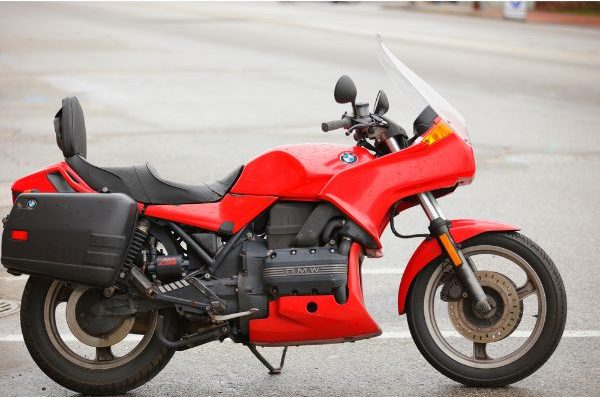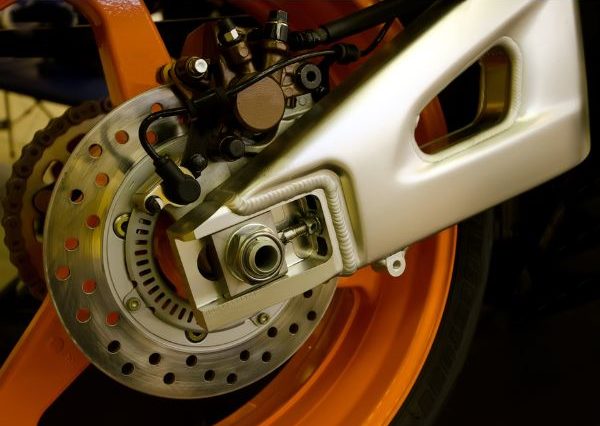Motorcycle manufacturers were much slower to adopt ABS systems on their products than car manufacturers. This was partly due to technological reasons, but there also seemed to be opposition within the biking fraternity.
In recent years, ABS and other rider aids have become commonplace on motorcycles, improving safety and saving lives.
What is ABS?
ABS stands for Anti-lock Braking System. Early systems were simple, and the equipment needed to function was large and heavy. This is partly why its introduction to motorcycles took longer than other vehicles.
A Brief History Of ABS
The first production car fitted with ABS was the Jensen FF in the 1960s, although Mercedes Benz disputes this and says theirs was the first in 1978. Either way, the first production motorcycle with ABS was the BMW K100, launched in 1988, at least ten years later.

Even in 1988, the BMW system was large and heavy, adding about 11 kg to the motorcycle’s weight. It was based on the car systems, where weight and size were less critical.
Motorcycle manufacturers quickly designed bike-specific ABS systems, and the most modern examples are small and weigh under 1 kg.
ABS systems have been compulsory in Europe on motorcycles over 125cc since 2016, but despite petitions, they are still optional in the US. That said, ABS is standard on around half of the motorcycle models available in the US, and most others offer it as an optional extra.
How Does ABS Work?
The theory is simple. Detect when a wheel is about to lock up, release the brake pressure momentarily to prevent it, and then reapply the brakes.
The pulsing of the brake in this way allows you to keep the braking pressure on while avoiding a crash.
Theory aside, how is this achieved?
Detecting wheel speed
On ABS-equipped motorcycles, you will notice an extra ring on the brake disc. It may be an additional ring or part of the main disc. You’ll see a series of gaps around the ring, and a sensor constantly monitors the speed of the gap’s rotation.

A basic ABS simply detects the wheel locking and releases the pressure. Modern systems now use electronic measurements from all over the motorcycle to determine if a wheel lock is about to occur.
Releasing The Brake Pressure
An ABS unit is fitted within the hydraulic brake system allowing it to adjust the brake pressure applied. Signals from the wheel sensors are fed to the ABS unit, and if a wheel lock is detected, the brake pressure is released and reapplied within a split second.
You can feel the pulsing effect of ABS on the brake lever, particularly in older systems. The pulsating at the lever is much less pronounced on more modern ABS systems.
Should You Have ABS On Your Bike?
Currently, you have this choice in the US, but for how long?
Who knows?
There is pressure to make it compulsory, as it is in various other countries and the EU.
Let’s take a quick look at the pros and cons of ABS. We’ll start with the cons first because, for me, there are very few reasons not to have ABS on your road bike.
Cons
- Extra weight. Previously an issue, but modern systems weigh less than 1 kg.
- Added complications to go wrong. Yes, this is true, but modern systems are incredibly reliable.
- Removes control from the rider. This is one reason many people avoid having ABS on their motorcycles. But let’s be honest, unless we practice our braking regularly and get extra training, we will never out-brake an ABS-equipped bike. Even with 40 years of riding experience, I include myself in that group. ABS offers an even more significant advantage when you throw in slippery roads and poor weather conditions.
- Extra cost. Yes, ABS will cost you more, but it’s now only a small premium.
- Extended brake distance in good conditions. This may seem odd, but a non-ABS bike can out-brake an ABS bike in dry conditions. Moto GP bikes are not equipped with ABS, as the rider has the skills to use the full potential of the braking system.
Pros
- Safer braking. Undoubtedly, a motorcycle with ABS will allow most riders to brake more safely. With reduced grip, the ABS will help keep you upright. Even when the road is bone dry, very few of us use the full potential of our motorcycle brakes. This is mainly through a lack of practice and the fear of locking the wheels. ABS helps to overcome this.
- Reduced braking distance. Knowing you have ABS, having the confidence to brake harder will reduce your braking distance. This alone could avoid an accident.
- Less serious accidents. Braking with confidence means that if you have an accident, you will probably be traveling more slowly at the point of impact, reducing injuries.
- Reduction in the number of accidents. The Insurance Institute for Highway Safety has conducted numerous studies showing that ABS can significantly reduce accident rates.
If you are still in doubt about the benefits of ABS on motorcycles, maybe this short video will help.
Future Developments And Improvements
While the basic principles of ABS remain the same, the technology is continually improving. More sensitive sensors and faster reacting ABS units improve the braking, reducing your stopping distance.
More significantly, lean-angle sensors and other advanced electronics have improved ABS systems.
Your motorcycle can now compensate not just for a slippery surface but also the reduced grip when cornering. Early motorcycle ABS systems couldn’t sense corning forces and consequently offered less crash protection.
Read more about motorcycle riding aids.
Finally
My current motorcycles don’t have ABS, but they are pretty old. However, whenever I buy a new bike, if it has the option of ABS, I will choose it. Despite my 40-plus years of riding, my reflexes are not as quick as the ABS. I also crashed recently and broke my collarbone, and I believe ABS would have saved me.